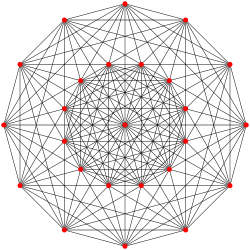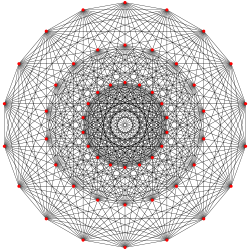
5 21 honeycomb
Encyclopedia
| E8 honeycomb | |
|---|---|
| Type | |Uniform honeycomb |
| Family | k21 polytope |
| Schläfli symbol | {3,3,3,3,3,32,1} |
| Coxeter symbol | 521 |
| Coxeter-Dynkin diagram Coxeter-Dynkin diagram In geometry, a Coxeter–Dynkin diagram is a graph with numerically labeled edges representing the spatial relations between a collection of mirrors... |
|
| 8-faces | 511 Octacross In geometry, an 8-orthoplex, or 8-cross polytope is a regular 8-polytope with 16 vertices, 112 edges, 448 triangle faces, 1120 tetrahedron cells, 1792 5-cells 4-faces, 1792 5-faces, 1024 6-faces, and 256 7-faces....  {37} |
| 7-faces | {36} |
| 6-faces | {35} |
| 5-faces | {34} |
| 4-faces | {33} Pentachoron In geometry, the 5-cell is a four-dimensional object bounded by 5 tetrahedral cells. It is also known as the pentachoron, pentatope, or hyperpyramid... |
| Cells | {32} Tetrahedron In geometry, a tetrahedron is a polyhedron composed of four triangular faces, three of which meet at each vertex. A regular tetrahedron is one in which the four triangles are regular, or "equilateral", and is one of the Platonic solids... |
| Faces | {3} Triangle A triangle is one of the basic shapes of geometry: a polygon with three corners or vertices and three sides or edges which are line segments. A triangle with vertices A, B, and C is denoted .... |
| Cell figure | 121 Demipenteract In five dimensional geometry, a demipenteract or 5-demicube is a semiregular 5-polytope, constructed from a 5-hypercube with alternated vertices deleted.It was discovered by Thorold Gosset... |
| Face figure | 221 Gosset 2 21 polytope In 6-dimensional geometry, the 221 polytope is a uniform 6-polytope, constructed within the symmetry of the E6 group. It was discovered by Thorold Gosset, published in his 1900 paper. He called it an 6-ic semi-regular figure....  |
| Edge figure | 321 Gosset 3 21 polytope In 7-dimensional geometry, the 321 polytope is a uniform 6-polytope, constructed within the symmetry of the E7 group. It was discovered by Thorold Gosset, published in his 1900 paper...  |
| Vertex figure Vertex figure In geometry a vertex figure is, broadly speaking, the figure exposed when a corner of a polyhedron or polytope is sliced off.-Definitions - theme and variations:... |
421 Gosset 4 21 polytope In 8-dimensional geometry, the 421 is a semiregular uniform 8-polytope, constructed within the symmetry of the E8 group. It was discovered by Thorold Gosset, published in his 1900 paper...  |
| Symmetry group Coxeter group In mathematics, a Coxeter group, named after H.S.M. Coxeter, is an abstract group that admits a formal description in terms of mirror symmetries. Indeed, the finite Coxeter groups are precisely the finite Euclidean reflection groups; the symmetry groups of regular polyhedra are an example... |
 , [35,2,1] , [35,2,1] |
In geometry
Geometry
Geometry arose as the field of knowledge dealing with spatial relationships. Geometry was one of the two fields of pre-modern mathematics, the other being the study of numbers ....
, the 521 honeycomb is a uniform tessellation
Uniform tessellation
In geometry, a uniform tessellation is a vertex-transitive tessellations made from uniform polytope facets. All of its vertices are identical and there is the same combination and arrangement of faces at each vertex....
of 8-dimensional Euclidean space.
This honeycomb was first studied by Gosset who called it a 9-ic semi-regular figure (Gosset regarded honeycombs in n dimensions as degenerate n+1 polytopes). In Coxeter's notation, Gosset's honeycomb is denoted by 521.
Each vertex of the 521 honeycomb is surrounded by 2160 8-orthoplexes and 17280 8-simplices.
The vertex figure
Vertex figure
In geometry a vertex figure is, broadly speaking, the figure exposed when a corner of a polyhedron or polytope is sliced off.-Definitions - theme and variations:...
of Gosset's honeycomb is the semiregular 421 polytope. It is the final figure in the k21 family.
Its vertex arrangement
Vertex arrangement
In geometry, a vertex arrangement is a set of points in space described by their relative positions. They can be described by their use in polytopes....
is called the E8 lattice
E8 lattice
In mathematics, the E8 lattice is a special lattice in R8. It can be characterized as the unique positive-definite, even, unimodular lattice of rank 8...
.
This honeycomb is highly regular in the sense that its symmetry group (the affine E8 Weyl group) acts transitively on the k-faces
Face (geometry)
In geometry, a face of a polyhedron is any of the polygons that make up its boundaries. For example, any of the squares that bound a cube is a face of the cube...
for k ≤ 6. All of the k-faces for k ≤ 7 are simplices.
Construction
It is created by a Wythoff constructionWythoff construction
In geometry, a Wythoff construction, named after mathematician Willem Abraham Wythoff, is a method for constructing a uniform polyhedron or plane tiling. It is often referred to as Wythoff's kaleidoscopic construction.- Construction process :...
upon a set of 9 hyperplane
Hyperplane
A hyperplane is a concept in geometry. It is a generalization of the plane into a different number of dimensions.A hyperplane of an n-dimensional space is a flat subset with dimension n − 1...
mirrors in 8-dimensional space.
The facet information can be extracted from its Coxeter-Dynkin diagram
Coxeter-Dynkin diagram
In geometry, a Coxeter–Dynkin diagram is a graph with numerically labeled edges representing the spatial relations between a collection of mirrors...
.
Removing the node on the end of the 2-length branch leaves the 8-orthoplex, 611.
Removing the node on the end of the 1-length branch leaves the 8-simplex.
The vertex figure
Vertex figure
In geometry a vertex figure is, broadly speaking, the figure exposed when a corner of a polyhedron or polytope is sliced off.-Definitions - theme and variations:...
is determined by removing the ringed node and ringing the neighboring node. This makes the 421 polytope.
The edge figure is determined from the vertex figure by removing the ringed node and ringing the neighboring node. This makes the 321 polytope.
The face figure is determined from the edge figure by removing the ringed node and ringing the neighboring node. This makes the 221 polytope.
The cell figure is determined from the face figure by removing the ringed node and ringing the neighboring node. This makes the 121 polytope
Demipenteract
In five dimensional geometry, a demipenteract or 5-demicube is a semiregular 5-polytope, constructed from a 5-hypercube with alternated vertices deleted.It was discovered by Thorold Gosset...
.
See also
- E8 latticeE8 latticeIn mathematics, the E8 lattice is a special lattice in R8. It can be characterized as the unique positive-definite, even, unimodular lattice of rank 8...
- 152 honeycomb
- 251 honeycomb

